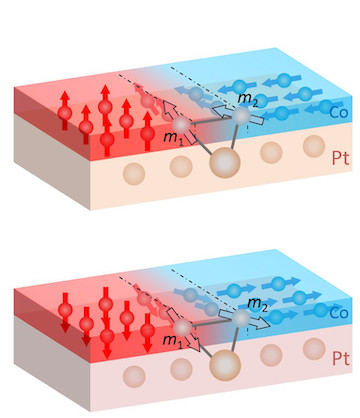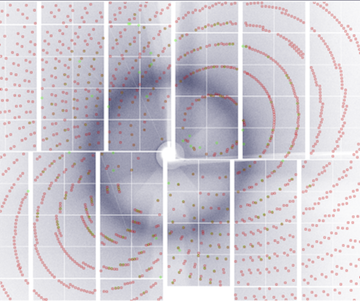|
|
Dear Colleagues
For users of PSI beamlines it’s all about energy, flux and spot size, isn’t it? However, progress in accelerator and detector technologies is leading to a massive growth of data generated from experiments. Increasing image resolution, 3D imaging and time-resolved data further accelerate this trend.
Therefore, PSI's large scale research facilities require complex data management pipelines, starting with data readout at detectors, real time data processing for fast feedback during the experiments, offline scientific analysis of data, archiving of raw and derived data and data retrieval at the end of the chain.
|

Gerd Mann
|
|
Our aim is to provide services for data management and processing. Remote access to a computing cluster with app. 8 PetaByte disk storage and 2’000 cores for offline analysis, data transfer services and a data catalogue are cornerstones. The data catalogue enables access to the PetaByte archive; a joint service operated by PSI and the Swiss National Supercomputing Centre CSCS with a capacity up to 100 PByte for long-term data preservation.
Next target is a pilot service providing direct access to the Piz Daint supercomputer for neartime and offline data analysis.
Gerd Mann,
on behalf of the PSI IT Department, Logistics Division
|
|
Next proposal submission deadlines:
SLS: non-PX-beamlines
deadline: September 15, 2019
more information
SwissFEL
deadline: September 15, 2019
more information
SLS: PX beamlines
deadline: October 15, 2019
more information
SµS
deadline: December 9, 2019
more information
Particle Physics
deadline: January 13, 2020
more information
SINQ (upgrade program 2019-20)
deadline: tba
more information
An overview of all proposal submission deadlines of the PSI facilities can be obtained here.
|
|
|
Chirally coupled nanomagnets
 SLS - Magnets side by side SLS - Magnets side by side
Coupling magnetic elements is central to realize magnetic and spintronic devices. Highly effective coupling schemes exist for vertically stacked structures, but not for laterally adjacent nanomagnets. At least not until now. Researchers at PSI and ETH Zurich established that the interfacial Dzyaloshinskii–Moriya interaction provides a general approach to build planar arrays of strongly correlated nanomagnets. In this scheme, coupling is mediated by chiral domain walls between out-of-plane and in-plane magnetic structures. That the coupling is effective, and chiral, was shown in particular by X-ray photoemission electron microscopy (X-PEEM) at the Swiss Light Source. The new scheme was used to assemble a range of planar nanomagnetic systems, including synthetic antiferromagnets and skyrmions, and to demonstrate current-induced switching - indicating the versatility and potential of the approach.
Read the full story
|
|
|
Z. Luo et al, Science 263, 1435 (2019)
|
|
|
Elementary excitation in the spin-stripe phase in quantum chains

SμS and SINQ - Room for wigglons
In recent years, the frustrated spin-1/2 chain β-TeVO4has been the source of excitement and mystery alike, and it continues to be so. In 2015, a periodic modulation of the spin order involving two magnetic order parameters has been identified in neutron experiments at PSI. New insight into that spin-stripe phase comes now from muon-spin-relaxation experiments, performed at PSI and the Rutherford Appleton Laboratory. These local-probe experiments, together with further neutron-diffraction measurements, revealed an elementary excitation inherent to the spin-stripe order, which is interpreted as a bound state of two phasons giving rise to a wiggling motion of the magnetic moments. That correlated dynamics at unusually low frequencies also led the researchers to a distinct name for these new excitations: wigglons.
Read the full story
|
|
|
M. Pregelj et al, npj Quantum Materials 4, 22 (2019)
|
|
|
First experiments using broadband mode
 SwissFEL - A new window opening SwissFEL - A new window opening
A team of PSI scientists, working with colleagues from the Centre for Free-Electron Laser Science in Hamburg, has recently performed the first serial femtosecond crystallography (SFX) experiment using the large-bandwidth mode of SwissFEL. In this mode, X-ray pulses with a bandwidth of up to 4% ΔE/E are available - some 20 times larger than for those generated in the nominal mode. The improvement is owing to the unique design of the SwissFEL electron accelerator, which enables the production of energy-chirped electron bunches. X-ray pulses created from such electron beams span a wider range of wavelengths than is currently achievable at any other XFEL. This capability helps mitigating the partiality problem in SFX, and opens up a window to new science opportunities with XFELs.
Read the full story
|
|
Max Zoller starts Ambizione project
 Particle Physics - Taking perturbative calculations to higher order Particle Physics - Taking perturbative calculations to higher order
On 1 June, Max Zoller started in the Particle Theory Group a four-year project for which he had received earlier this year a Swiss National Science Foundation Ambizione grant. The focus of his research are perturbative higher-order calculations for the Large Hadron Collider. Precise predictions for the widest-possible spectrum of scattering processes are crucial to identify any experimental signatures of physics beyond the Standard Model. Over the past decade, next-to-leading-order (NLO) calculations have been fully automated. Max Zoller, together with a PhD student, will now expand that toolbox and develop a fully automated algorithm for calculating next-to-next-to-leading-order (NNLO) amplitudes for 2→2 and 2→3 particle processes, and extend the NLO algorithm for processes with many scattering particles and challenging kinematical configurations.
|
|
High-numerical-aperture optics for ultra-fast tomographic microscopy
SLS
A novel high-performance custom-made macroscope, dedicated to high-resolution time-resolved X-ray tomographic microscopy, is now available for the user community at the TOMCAT beamline. The macroscope offers a 4x magnification and has a very high numerical aperture of 0.35. Coupled to the in-house developed GigaFRoST camera, this new, highly efficient imaging setup enables tomographic investigations with high temporal and high spatial resolution: tomographic microscopy studies with a time resolution of 20 Hz and beyond have become possible, unlocking unprecedented possibilities for the tomographic investigation of dynamic processes and radiation-sensitive samples. A detailed characterization of the macroscope performance is provided here. |
|
SINQ guide upgrade: well on track
SINQ
The SINQ guide upgrade project has achieved a number of important milestones. After removing all old guides we are now already in the phase of installing the new components. In May 2019 we passed the most critical milestone of the project, the installation of the in-pile section of the guide system. That means the first 4.5 m guide section closest to the cold source is now successfully installed. This milestone is very important for the planned SINQ operation in 2020 as we now have the permission to install the new SINQ target. The next milestone is the installation in the neutron guide bunker, which will start in August 2019 and will be finished by January 2020.
|
|
Successful test of a solid Neon moderator at LEM
SμS
Last December, at the LEM instrument a solid Neon moderator was successfully tested for 24 hours for the first time. s-Ne has a 60-70% higher moderation efficiency compared to the routinely used s-Ar moderator, and we could generate a new world record low-energy muon rate at the moderator of about 15k/s at a proton beam current of 1.9 mA and 4-cm-long target E. This is expected to increase to about 25k/s for a slanted target E (to be tested in December 2019), and for a normal proton beam current of 2.3 mA, which will be again available from 2020 on. Long-term feasibility tests with s-Ne will be continued in 2019 with a maximum extraction voltage at the moderator of 12 kV. For routine operation we continue to use the much more stable s-Ar moderator in 2019.
|
|
muCool: a next step towards efficient muon beam compression
Particle Physics
A novel device to compress the phase space of a muon beam by a factor of 10 10 with a 10 −3 efficiency is under development. A surface muon beam is stopped in a helium gas target consisting of several compression stages, wherein strong electric and magnetic fields are applied. The spatial extent of the stopped muon swarm is decreased by means of these fields until muons with eV energy are extracted into vacuum through a small orifice. It was observed that a 20 cm long muon stop distribution can be compressed in the longitudinal direction to a sub-mm extent within 2 μs. Additionally, a drift perpendicular to the magnetic field of the compressed low-energy muon swarm was successfully demonstrated, paving the way towards extraction from the gas and re-acceleration of the muons, more information. |
|
Safety at PSI - new online training available
all facilities and users of PSI
PSI requires that all users complete an online safety training before they start working at one of the PSI large scale user facilities. This training has to be renewed every two years. The previous Powerpoint course has now been replaced by a modern online training, which is integrated into the badge application procedure via the DUO system. Whenever you apply for a badge/dosimeter DUO will check if you need to perform/repeat the training and will guide you to the course before your badge application is processed.
Should you have any questions about the training, do not hesitate to contact the PSI User Office. |
|
JUSAP - The Joint Users Association
Dear colleagues
The upgrade of the SINQ neutron guides makes good progress. In a first step the insert and guides close to the spallation source were replaced. This critical operation was successfully completed in May 2019. The replacement of the neutron guides in the experimental hall will follow next. All tasks are in time and restart of SINQ is expected for May 2020. The next SINQ proposal deadline will be announced in due time.
|

Claude Monney
|
|
The 2nd CALIPSOplus annual meeting took place on June 3rd-4th, 2019 at the ASTRID 2 synchrotron of Aarhus University, Denmark. Reports about the progress achieved within the different CALIPSOplus workpackages, including those involving the European Synchrotron and FEL User Organisation (ESUO) as well as synchrotron-based studies from two research teams were presented. Within CALIPSOplus, ESUO is fostering e.g. (i) the bridging with other important user communities (high magnetic fields, neutrons, muons, …) and (ii) the synergies with the CALIPSOplus twinning team enabling scientists in widening countries to become new users of synchrotron radiation and FEL user facilities in Europe.
We encourage you, members of the PSI user community, to communicate to us any issues, concerns or suggestions. In this case, please contact us, committee members, directly.
Yours sincerely,
Claude Monney, Annick Froideval, and Karl Kraemer on behalf of the JUSAP committee
|
|
Upcoming events
Please have a look at our conference calendar.
|
|
|
|